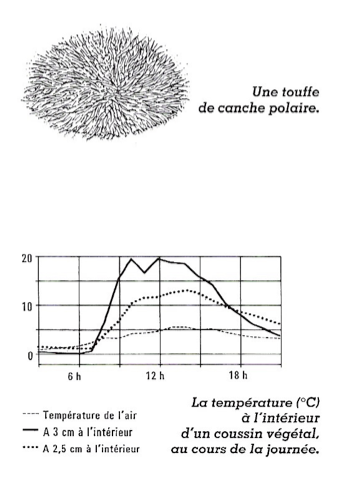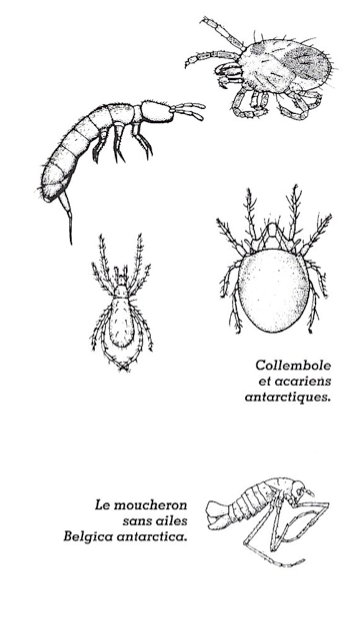Polar Encyclopædia
ANTARCTIC TERRESTRIAL FLORA AND FAUNA

Of the temperate Antarctic of the Tertiary period, nothing, or almost nothing, remains. The formation of the ice cap has caused the disappearance of almost all flowering plants and all higher land animals (penguins and mammals are marine). Only a few invertebrates endure the polar winter, on the rare areas left uncovered by the ice (2% of the total surface). The richest Antarctic life is found on the peninsula, where the softening influence of the ocean allows the growth of some vegetation cover.
There are only two species of flowering plants south of the 55th parallel: a grass, the antarctic canary grass (Deschamp sia antarctica) and the polar sago grass (Colobenthus quitensis), growing in cushions.
Banks of mosses cover the wetlands and lichens -both algae and fungi- cover the drier rocks. Less rich than the islands of the Scotia arc or the peninsula, the continent itself contains only 100 species of mosses, 200 species of lichens and only one liverwort (Cephaloziella exiliflora). This vegetation is adapted to retain the little water, to support the frost and to take advantage of the length of the polar day (photosynthesis often active until 0°C). Lichens live up to 86°S, 400 km from the pole, and even in the "dry valleys", withstanding -60 °C and 16 % humidity. In South Orkney and South Shetland, there are peat bogs several thousand years old (growth rate of about 1 mm per year).

Non-marine algae are present on the continent. Most of them are microscopic. They multiply at the bottom of lakes and cover the gravel of wet soils, sometimes coloring the soil (blue-green algae) or the snow (red-pigmented algae). Fungi, yeasts and bacteria also live in rock crevices and in the soil.
Small invertebrates with a rapid reproduction cycle can take advantage of the Antarctic summer. The succession of all the larval stages sometimes requires several winters. We meet mites, nematodes, tardigrades, springtails, midges and rotifers. The giant of Antarctica is a 12 mm wingless midge: Belgica antarctica. Other invertebrates live in the lakes (copepod crustaceans); others still proliferate as parasites (lice, ticks, worms...) on or in the bodies of higher animals.
The terrestrial flora and fauna of the sub-Antarctic islands are richer than those of Antarctica, which are always limited to a few endemic species. They are developed in the geography sheets.
For more details :
Books
- L’Antarctique (Trad. Avérous/Mazin)
- Livre de Greenpeace (May)
- À la découverte des TAAF (Hureau, Muséum d’histoire naturelle de Marseille)
Support the project with a donation
The Polar POD expedition is one of the stamp of the pioners, a human adventure coupled with a technological challenge, an oceanographic exploration never before carried out which will mark a milestone in the discovery of the oceans.
Thank you for your support !